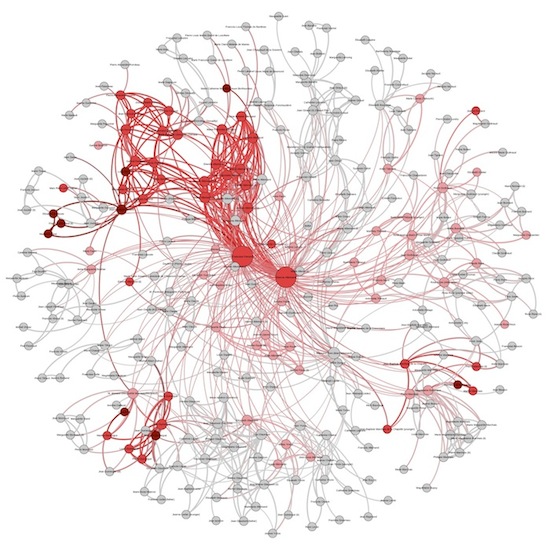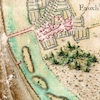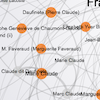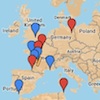A MARRIAGE CONTRACT IN ANGOULEME
|
||||||||
On December 9, 1764, Françoise Ferrand, the daughter of a joiner in Angoulême, and Étienne Allemand, the son of a tailor, signed an unusual pre-nuptial contract. They commit all their goods and rights, present and future, including any goods that might come to Françoise from the estate of her late father, who had died in Martinique, "in whatever they might consist, and in whatever place they might be found." The most unusual part of the record is the conclusion. The contract was signed by "the parties and their relatives who were present" and the signatures extend over two pages: the contract was signed by eighty-three people.
The signatures on the contract, which is in the notarial records in the Archives départementales de la Charente, are shown in the images to the right. "Contract Signatories" and "Overseas Connections," above, are visualizations of the social relationships of the eighty-three individuals, together with other individuals who constituted their social networks in the town. These "other individuals" have at least one of the following relationships to a signatory of the marriage contract: parent, child, sibling, spouse, or "godparent-relation" (godparent of, godchild of, godparent to the child of, co-godparent with.) The figure labeled "Contract Signatories" shows the signatories, together with 221 of their relatives and friends.
The identifications shown here are incomplete. They are limited to individuals who were alive during the lifetime of Françoise Ferrand's mother, Marie Aymard, who was born in Angoulême in 1713, and died there in 1790. But the visualizations do provide some indication of the diffusion of information across the networks of provincial life in eighteenth-century France. Other people are the "primary conduits of information, opinions, and behaviors," as economists interested in social networks have shown, and "encounters with neighbors are one important mechanism by which social norms are transmitted." The figure labeled "Overseas Connections" depicts the encounters, or the probability of the encounters, in which social information – in this case, information about the long-distance economy – was transmitted. Individuals who had traveled outside France are colored dark red in the visualizations, and those with a family member who had lived outside France are colored light red. The individuals who are colored pink had one or more of the following connections to the outside world: they or a relative had been contractors to the army or navy; they or a member of their household had been selected for the militia in the lottery in Angoulême in 1758; or they were immediate neighbors (inhabitants of the same "island," or cluster of houses, as listed in the tax registers) of someone who had lived outside France.
"Contrat de marriage de Estienne Allemand et Françoize Ferrand," December 9, 1764, Archives départementales de la Charente, Bernard, notary, 2E153.
Benjamin Golub and Matthew O. Jackson, "Naïve Learning in Social Networks and the Wisdom of Crowds," American Economic Journal: Microeconomics 2, no. 1 (2010): 112–149, 112.
Assar Lindbeck, Mårten Palme and Mats Persson, "Social Interaction and Sickness Absence," Research Papers in Economics, Department of Economics, Stockholm University, 2009:4, https://swopec.hhs.se/sunrpe/abs/sunrpe2009_0004.htm
Emma Rothschild, "Isolation and Economic Life in Eighteenth-Century France," American Historical Review 119, no. 4 ( 2014): 1055-1082.






